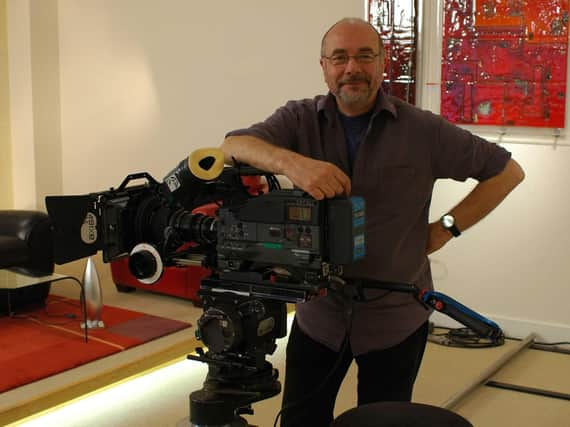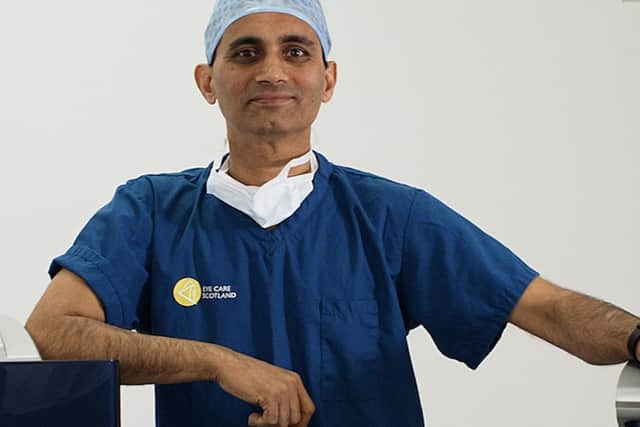'˜Blind' TV camera-man from Edinburgh gets his eyesight back


Throughout his career in television, he’s worked alongside superstars like David Bowie and counted presenter Paula Yates among his friends.
So when an eye examination revealed his sight was so bad that he could easily be registered blind, the realisation of what he was at risk of losing left John reeling.
“I already wore glasses, but over the last couple of years my eyesight had deteriorated,” he recalled. “I went to the optician who told me that I not only had a cataract, but that it was already pretty bad.


“I knew it was imperative that I had it treated.”
As it turned out, the cataract quickly took hold to the point that it became increasingly difficult for John (71), who lives near Dalkeith, to carry out every day functions.
“The last filming job I went out on, someone else had to drive as my sight was so bad it had become illegal for me to get behind the wheel,” he said.
“I could still use my camera by adjusting the eye piece, but looking at things that were in the distance or closer, like a computer screen, was getting harder and harder.”
Today, however, John’s vision isn’t just back to normal. Cataract surgery and lens replacement surgery has been so effective, that his eyesight is now on a par with someone 50 years younger.
And he is back behind his camera, seeing through fresh eyes which have brought colours back to life and sharpened up the world around him.
Cataracts cause the eye’s lens to cloud and vision to become misty. In many cases, colours are washed out and there’s a sensitivity to bright lights.
They can affect one or both eyes, and affect around half of people who are in their 80s – and many people who are younger, too. They develop slowly and can go unnoticed until they have already caused significant damage, which means catching them early is vital.
Long NHS waiting lists, however, have seen many patients opt instead for fast and effective private treatment – particularly when it can also help correct vision problems.
Rather than join the waiting list for NHS cataract surgery, John opted to explore his options with Laser Vision Scotland, a laser eye centre in Scotland fully regulated by Health Improvement Scotland’s Healthcare Environment Inspectorate (HIS HEI). Its surgeons are also regulated and revalidated by the General Medical Council.
“It turned out that I had cataracts in both eyes,” he said. “I could have had the same kind of cataract surgery that’s available on the NHS, but I opted to have lens replacement surgery which would give me an improved kind of lens – the equivalent of putting a Nikon lens on a camera.
“Because I rely so much on my sight, it made perfect sense to go ahead.”
John received his treatment in Edinburgh, with each eye being tackled a week apart.
“I might have been more apprehensive than some because of how important my vision is to what I do,” he said. “But it was straight-forward, pain free and the results have been incredible.”
According to eye surgeon Mr Sanjay Mantray, the procedure is highly effective, with impressive results.
“You are awake during surgery, there’s no general anaesthetic needed, and there’s no injections or needles,” he said. “An operation which used to take 90 minutes is now done in 15. There are no stitches needed, it’s all done with a micro incision of less than 2mm.”
Patients simply lie on a bed, and feel cool water in their affected eye. They then see a kaleidoscope of colours before a clear plastic pad is placed over their eye.
Remarkably, they can see straight away – although their vision is likely to be a little blurred at first. After a short spell of observation on a ward, they are normally given the go-ahead to return home within around an hour.
“The plastic shield over their eye is removed next day, and vision is typically up to 20:20 driving standard with two days,” added Mr Mantray.
John says the results have been even better than he expected. “I hadn’t realised how much the colours I was seeing had turned neutral.
Before surgery everything was cloudy and a bit sepia.
“Afterwards I was seeing things in technicolour once again! It’s not just given me back my vision. My confidence has come back too, so it really has been life-changing.”
Laser Vision Scotland has modern facilities in Edinburgh, Glasgow and Stirling, and offers a wide range of treatments to help rectify various eye problems, including laser eye surgery for vision correction, implantable lens surgery to help patients who are short or long-sighted, as well as treatment for macular degeneration and other less common conditions.
Find out more about the range of eye treatments, including cataract
surgery and lens replacement, available at Laser Vision Scotland at www.laservisionscotland.co.uk